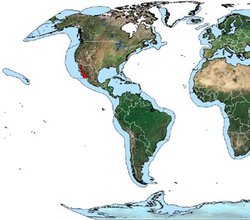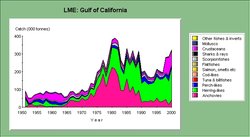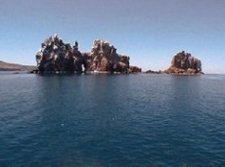Gulf of California large marine ecosystem
 Map of the Gulf of California. (Source: NOAA)
Map of the Gulf of California. (Source: NOAA) The Gulf of California Large Marine Ecosystem (LME) is characterized by its temperate climate. It is a semi-enclosed LME bordered by Baja California and by mainland Mexico. The LME is also known as the Sea of Cortez. It is enriched by a high level of nutrients (FAO (Food and Agriculture Organization (FAO)), 2003). Winds, tidal action and upwelling characterize the LME. It has mixed semi-diurnal tides and one of the greatest tidal ranges on Earth.
Contents
Productivity
The LME is long and narrow (1500 kilometers (km) long by 175 km wide) and verges with the Pacific Ocean. The Gulf of California is one of the youngest ocean bodies, formed by the separation of the North American and Pacific plates by tectonic movement. The LME's southern part includes the 2000 meter-deep Guaymas Trench. The trench has volcanic and hydrothermal vents, and supports biotic communities based on hydrogen sulfide rather than sunlight for energy. The LME's northern part receives a large amount of silt produced by the Colorado River. The tide can reach nine meters in difference of level in the northern part of the gulf. The Gulf of California Large Marine Ecosystem is classified as a Class I, highly productive (>300 gC/m2-yr) ecosystem based on global SeaWiFS primary productivity estimates. For more information on currents, mixing and water masses, nutrients, primary productivity, phytoplankton and zooplankton, (S. Alvarez-Borrego, 1983). Sardines and anchovies are the main food of large quantities of squid, fish, marine birds, and marine mammals (sea lions, fin whales, dolphins, orcas, and elephant seals). The ecosystem serves as a nursery ground for the gray whale, and is a breeding areas for marine birds and mammals (Herring's gull, Larus heermanni, tern (Sterna maxima), and California sea lion). The northern gulf has many endemic species including endemic populations of the vaquita (an endangered (IUCN Red List Criteria for Endangered) harbor porpoise) and the totoaba (a large endangered fish). Because the Colorado River once flowed into the Gulf of California, but now rarely does, many changes are occurring in the estuarine environment at the far northern end. Sedimentation and changes in the environment brought about by the loss of inflow favor the isolation of species and their consequent speciation.
Fish and Fisheries
 Graph of Marine Life. (Source: NOAA)
Graph of Marine Life. (Source: NOAA) This LME has a high variability in catches. The Food and Agriculture Organization (FAO) 10-year trend shows an increase in the catch from 330,000 tons in 1990 to 360,000 in 1999 (see FAO, 2003), with a crash in 1992 down to 240,000 tons. Another crash occurred in 1998. The most important species group in terms of shelf catches are clupeoids (herrings, sardines and anchovies), representing in most years almost ¾ of the total catch. For more information on the anchovy, see Hammann, 1989. There are abundant and healthy stocks of lutjanids, sparids and serranids (snappers, porgies, groupers). With higher rates of fishing mortality and the escalation of gear types to gill nets, trawls and longlines, there has been a fairly rapid reduction in total standing stocks, switches in species dominance and the loss of older age classes of larger fish. There was once a fishery (Fisheries and aquaculture) of the totoaba (Cynoscion macdonaldi), an endemic fish of the northern gulf, but this fishery does not exist any more. The apex predators of the LME appear to have declined to very low levels. The stocks of highly migratory species (marlin, sailfish, tunas) are in decline, which affects the sport fishery within the LME. This reduction is likely due to bycatch mortality. It is possible that stock reserves in the eastern tropical Pacific are sufficient to restore the abundance of these species within the LME. However, the continuing excessive mortality of the large pelagic predators could have substantial and possibly irreversible effects on the structure and function of the LME. The loss of apex predator biomass could trigger a broad expansion in the biomass of ctenophores, jellyfishes, squid and small pelagic fishes (sardines, anchovies, etc.). Such a shift in biomass dominance to planktivorous species would alter the structure of the LME. NOAA's Monterrey Bay office is currently evaluating the effects of overfishing in the LME. For more information on fish populations in the Gulf of California, see S. Alvarez-Borrego, 1983. For detailed fish catch statistics for this LME, see data collected by the University of British Columbia Fisheries Center. For statistics on Mexican fishing and catches, see the UN Food and Agriculture Organization website.
Pollution and Ecosystem Health
 Gulf of California. (Source: NOAA)
Gulf of California. (Source: NOAA) Human activities are altering [[ecosystem]s] in the Gulf of California. The decrease of Colorado River freshwater input has changed the ecological conditions of what used to be an estuarine system, important for fish reproduction. It is now an area of high salinity. Pollution problems include agriculture inputs and runoff from the Colorado River in the upper Gulf. Pesticides are used in the agricultural areas of the Mexicali valley and of the Sonora and Sinaloa states. The main issue affecting ecosystem health has been the escalation of fishing vessels and fishing gear types, from small pangas, handlines with multiple hooks and spearguns, to gill nets, trawls and longlines. Species in danger of economic extinction in this LME include the cabrilla, black and white seabass, Gulf grouper, yellowtail, dog snapper and sierra. Sea turtles, hammerhead sharks, and giant manta rays are virtually gone. The LME has however shown a resilience that is partly due to its coastal watersheds and to the submarine topography that causes the upwelling of nutrients. More information on ecosystem health can be found at the University of California at Santa Cruz website.
Socioeconomics
Fisheries in the Gulf of California Large Marine Ecosystem are significant in providing food for millions of Mexicans. In the late 1970s, Mexican fishermen who had previously used pangas and handlines began to use gillnets. This led to a significant increase of the catch. By the mid-1980s, the number of larger boats had dramatically increased. Commercial boats from mainland Mexico, where fish stocks are depleted, fish along the Baja coast. A once thriving tourist attraction of sea turtles, hammerhead sharks, and giant manta rays in the Gulf of California has now virtually disappeared, due apparently to the indiscriminate use of gillnets in fisheries. Locals must seek alternative sources of income to make a living. The challenge is to balance low to moderate harvest levels for domestic consumption, and sportfishing, diving and other low-impact ecotourism activities, such as whale watching and bird watching. This approach would maximize economic benefits to the residents of Baja del Norte, Baja Del Sur, Sinaloa and Sonora, as well as help bring about the recovery of fish stocks to higher levels of abundance.
Governance
 Marine Life. (Source: NOAA)
Marine Life. (Source: NOAA) The Gulf of California Large Marine Ecosystem is governed by a single country, Mexico. Frustrated by decades of overfishing and mismanagement, people are making a stand for greater local control over the LME's marine resources, more law enforcement and more governmental integrity. In 1998, former Mexican President Ernesto Zedillo asked the governors of the four states bordering the Sea of Cortez to prepare a plan for the regional long-term use of its resources. The move indicated a shift from economic exploitation to environmental protection, and a loosening of the federal government's historic control over the region. Initiatives by local residents aim to safeguard the coast from poaching, promote marine conservation and exert local control over fish and shellfish. The USA is providing financial assistance. The Sea of Cortez International Preservation Foundation seeks to motivate change in policies for the purpose of preserving the biological diversity and ecological balance of the LME. Effective management needs good data. Current information on catch and effort by area and gear type is very limited. A program for collecting and analyzing data from both the recreational and commercial sectors is needed. There are two marine parks: the Cabo Pulmo National Marine Park, and the Loreto National Marine Park. There is a need to develop public education, develop the ecotourism economy, and seek stronger legislation and regulations prohibiting the use of certain types of fishing gear.
References
- Alvarez-Borrego, S., 1983. "Gulf of California". In: Ecosystems of the World: Estuaries and Enclosed Seas. B.H. Ketchum, ed. Elsevier Scientific Publishing House. pp. 427-449. ISBN: 0444419217.
- Cisneros, M.A., M.O. Nevarez, G. Montemayor, J.P. Santos, and R. Morales. 1991. Pesqueria de la sardina en el Golfo de California 1988/1989?1989/1990. Boletin del Centro Regional de Investigacion Pesquera de Guaymas. Guaymas, Sonora: Instituto Nacional de Pesca, Secretaria de Pesca. 80pp. NOAA. 1991. Report of the ad hoc Committee on Large Marine Ecosystems. NOAA Technical Memorandum NMFS-F/NEC-92, 19p.
- Hammann, M.G. and M.A. Cisneros. 1989. Range extension and commercial capture of the northern anchovy, Engraulis mordax Girard in the Gulf of California, Mexico. Calif. Fish. Game 75(1): 49-53.
- Hammann, M.G., T.R. Baumgartner, and A. Badan-Dangon. 1988. Coupling of the Pacific sardine (Sardinops sagax caeruleus) life cycle with the Gulf of California pelagic environment. Calif. Coop. Oceanic Fish. Invest. Rep. 29: 102-109.
- Thompson, D. A., 1979. Reef Fishes of the Sea of Cortez. Wiley.
| Disclaimer: This article contains some information that was originally published by, the National Oceanic and Atmospheric Administration (NOAA). Topic editors and authors for the Encyclopedia of Earth have edited its content and added new information. The use of information from the NOAA should not be construed as support for or endorsement by that organization for any new information added by EoE personnel, or for any editing of the original content. |